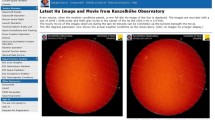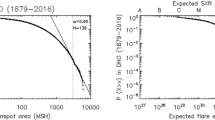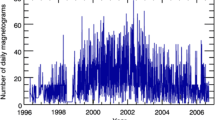Abstract
The physical processes that trigger solar flares are not well understood, and significant debate remains around processes governing particle acceleration, energy partition, and particle and energy transport. Observations at high resolution in energy, time, and space are required in multiple energy ranges over the whole course of many flares to build an understanding of these processes. Obtaining high-quality, co-temporal data from ground- and space- based instruments is crucial to achieving this goal and was the primary motivation for starting the Max Millennium program and Major Flare Watch (MFW) alerts, aimed at coordinating observations of all flares ≥ X1 GOES X-ray classification (including those partially occulted by the limb). We present a review of the performance of MFWs from 1 February 2001 to 31 May 2010, inclusive, which finds that (1) 220 MFWs were issued in 3407 days considered (6.5 % duty cycle), with these occurring in 32 uninterrupted periods that typically last 2 – 8 days; (2) 56% of flares ≥ X1 were caught, occurring in 19 % of MFW days; (3) MFW periods ended at suitable times, but substantial gain could have been achieved in percentage of flares caught if periods had started 24 h earlier; (4) MFWs successfully forecast X-class flares with a true skill statistic (TSS) verification metric score of 0.500, that is comparable to a categorical flare/no-flare interpretation of the NOAA Space Weather Prediction Centre probabilistic forecasts (TSS = 0.488).


Similar content being viewed by others
Notes
See http://solar.physics.montana.edu/max_millennium/ops/op003/op003.html for the currently operating MFW criteria.
Despite being sent, the MMCO email for 21 August 2002 is missing from the archive located here http://solar.physics.montana.edu/hypermail/mmmotd/index.html . This day was treated as having a MFW called on the same target region as the MFW days preceding and following (NOAA 10069), with an issue time of 13:00 UTC (roughly the same as the previous day).
References
Aschwanden, M.J., Freeland, S.L.: 2012, Automated solar flare statistics in soft X-rays over 37 years of GOES observations: The invariance of self-organized criticality during three solar cycles. Astrophys. J. 754, 112. DOI . ADS .
Atwood, W.B., Abdo, A.A., Ackermann, M., Althouse, W., Anderson, B., Axelsson, M., et al.: 2009, The Large Area Telescope on the Fermi gamma-ray space telescope mission. Astrophys. J. 697, 1071. DOI . ADS .
Bloomfield, D.S., Higgins, P.A., McAteer, R.T.J., Gallagher, P.T.: 2012, Toward reliable benchmarking of solar flare forecasting methods. Astrophys. J. Lett. 747, L41. DOI . ADS .
Bobra, M.G., Couvidat, S.: 2015, Solar flare prediction using SDO/HMI vector magnetic field data with a machine-learning algorithm. Astrophys. J. 798, 135. DOI . ADS .
Colak, T., Qahwaji, R.: 2009, Automated solar activity prediction: A hybrid computer platform using machine learning and solar imaging for automated prediction of solar flares. Space Weather 7, 6001. DOI . ADS .
Crown, M.D.: 2012, Validation of the NOAA space weather prediction center’s solar flare forecasting look-up table and forecaster-issued probabilities. Space Weather 10, 6006. DOI . ADS .
Falconer, D.A., Moore, R.L., Gary, G.A.: 2008, Magnetogram measures of total nonpotentiality for prediction of solar coronal mass ejections from active regions of any degree of magnetic complexity. Astrophys. J. 689, 1433. DOI . ADS .
Gallagher, P.T., Moon, Y.-J., Wang, H.: 2002, Active-region monitoring and flare forecasting I. Data processing and first results. Solar Phys. 209, 171. DOI . ADS .
Georgoulis, M.K., Rust, D.M.: 2007, Quantitative forecasting of major solar flares. Astrophys. J. Lett. 661, L109. DOI . ADS .
Hale, G.E., Ellerman, F., Nicholson, S.B., Joy, A.H.: 1919, The magnetic polarity of sun-spots. Astrophys. J. 49, 153. DOI . ADS .
Hanssen, A.W., Kuipers, W.J.A.: 1965, On the relationship between the frequency of rain and various meteorological parameters. Meded. Ver. 81. Royal Netherlands Meteorological Institute.
Heidke, P.: 1926, Berechnung des Erfolges und der Güte der Windstärkevorhersagen im Sturmwarnungsdienst. Geogr. Ann. 8, 310.
Hudson, H.S., Fisher, G.H., Welsch, B.T.: 2008, Flare energy and magnetic field variations. In: Howe, R., Komm, R.W., Balasubramaniam, K.S., Petrie, G.J.D. (eds.) Subsurface and Atmospheric Influences on Solar Activity, ASP Conf. Ser. 383, 221. ADS .
Hudson, H.S., Peterson, L.E., Schwartz, D.A.: 1969, The hard solar X-ray spectrum observed from the third orbiting solar observatory. Astrophys. J. 157, 389. DOI . ADS .
Kazachenko, M.D., Fisher, G.H., Welsch, B.T.: 2014, A comprehensive method of estimating electric fields from vector magnetic field and Doppler measurements. Astrophys. J. 795, 17. DOI . ADS .
Kretzschmar, M.: 2011, The sun as a star: Observations of white-light flares. Astron. Astrophys. 530, A84. DOI . ADS .
Krucker, S., Giménez de Castro, C.G., Hudson, H.S., Trottet, G., Bastian, T.S., Hales, A.S., et al.: 2013, Solar flares at submillimeter wavelengths. Astron. Astrophys. Rev. 21, 58. DOI . ADS .
Künzel, H.: 1960, Die Flare-Häufigkeit in Fleckengruppen unterschiedlicher Klasse und magnetischer Struktur. Astron. Nachr. 285, 271. ADS .
Lin, R.P., Dennis, B.R., Hurford, G.J., Smith, D.M., Zehnder, A., Harvey, P.R., et al.: 2002, The Reuven Ramaty High-Energy Solar Spectroscopic Imager (RHESSI). Solar Phys. 210, 3. DOI . ADS .
MacTaggart, D.: 2011, Flux emergence within mature solar active regions. Astron. Astrophys. 531, A108. DOI . ADS .
Mason, J.P., Hoeksema, J.T.: 2010, Testing automated solar flare forecasting with 13 years of Michelson Doppler Imager magnetograms. Astrophys. J. 723, 634. DOI . ADS .
McIntosh, P.S.: 1990, The classification of sunspot groups. Solar Phys. 125, 251. DOI . ADS .
Murray, S.A., Bloomfield, D.S., Gallagher, P.T.: 2012, The evolution of sunspot magnetic fields associated with a solar flare. Solar Phys. 277, 45. DOI . ADS .
Sawyer, C., Warwick, J.W., Dennett, J.T.: 1986, Solar Flare Prediction, Colorado Associated University Press, Boulder, CO. ADS .
Schrijver, C.J.: 2007, A characteristic magnetic field pattern associated with all major solar flares and its use in flare forecasting. Astrophys. J. Lett. 655, L117. DOI . ADS .
Schrijver, C.J., De Rosa, M.L., Title, A.M., Metcalf, T.R.: 2005, The nonpotentiality of active-region coronae and the dynamics of the photospheric magnetic field. Astrophys. J. 628, 501. DOI . ADS .
Song, H., Tan, C., Jing, J., Wang, H., Yurchyshyn, V., Abramenko, V.: 2009, Statistical assessment of photospheric magnetic features in imminent solar flare predictions. Solar Phys. 254, 101. DOI . ADS .
White, S.M., Benz, A.O., Christe, S., Fárník, F., Kundu, M.R., Mann, G., et al.: 2011, The relationship between solar radio and hard X-ray emission. Space Sci. Rev. 159, 225. DOI . ADS .
Zirin, H., Marquette, W.: 1991, BEARALERTS – a successful flare prediction system. Solar Phys. 131, 149. DOI . ADS .
Acknowledgements
The authors wish to thank the excellent efforts of both our newest MMCO (Ying Li) and past MMCOs who have contributed since 2001 (in alphabetical surname order: Paul A. Higgins, R.T. James McAteer, and Claire L. Raftery), Keiji Yoshimura for maintaining the Max Millennium website, and the referee for useful comments that helped improve the manuscript. The Max Millennium program has been supported by the enlightened RHESSI PI team led by Principle Investigator Robert P. Lin (later Säm Krucker) and Project Scientist Brian R. Dennis through Sub-agreement No. SA-1868 26308PG between University of California, Berkeley and Montana State University. DSB received funding from the European Space Agency PRODEX Programme and the European Union’s Horizon 2020 Research and Innovation Programme under grant agreement No. 640216 (FLARECAST project). ROM received funding from NASA LWS/TR&T grant NNX11AQ53G and NASA LWS/SDO Data Analysis grant NNX14AE07G.
Author information
Authors and Affiliations
Corresponding author
Rights and permissions
About this article
Cite this article
Bloomfield, D.S., Gallagher, P.T., Marquette, W.H. et al. Performance of Major Flare Watches from the Max Millennium Program (2001 – 2010). Sol Phys 291, 411–427 (2016). https://doi.org/10.1007/s11207-015-0833-6
Received:
Accepted:
Published:
Issue Date:
DOI: https://doi.org/10.1007/s11207-015-0833-6




